Photoluminescent Lanthanide(III) Coordination Polymers with Bis(1,2,4-Triazol-1-yl)Methane Linker
Abstract
1. Introduction
2. Results and Discussion
2.1. Synthesis of the Coordination Polymers
2.2. Crystal Structures of the Coordination Polymers
2.3. Thermogravimetric, Powder X-ray Diffraction Analyses, and IR Spectroscopy
2.4. Photoluminescent Properties of the Coordination Polymers
3. Materials and Methods
3.1. Synthetic Procedures
3.1.1. Synthesis of {[Eu(btrm)2(NO3)3]·4H2O}n (1) Coordination Polymer
3.1.2. Synthesis of {[Tb(btrm)2(NO3)3]·3H2O}n (2) Coordination Polymer
3.1.3. Synthesis of {[Sm(btrm)2(NO3)3]·H2O}n (3) Coordination Polymer
3.1.4. Synthesis of {[Dy(btrm)2(NO3)3]·H2O·MeCN}n (4) Coordination Polymer
3.1.5. Synthesis of {[Gd(btrm)2(NO3)3]·H2O}n (5) Coordination Polymer
3.1.6. Synthesis of Single Crystal of the Coordination Polymers {[Ln(btrm)2(NO3)3]·xMeCN}n (1a–4a)
3.2. Methods of Characterization
3.3. Single-Crystal and Powder X-ray Diffraction Analyses
4. Conclusions
Supplementary Materials
Author Contributions
Funding
Data Availability Statement
Acknowledgments
Conflicts of Interest
References
- Beltrán-Leiva, M.J.; Solis-Céspedes, E.; Páez-Hernández, D. The role of the excited state dynamic of the antenna ligand in the lanthanide sensitization mechanism. Dalton Trans. 2020, 49, 7444–7450. [Google Scholar] [CrossRef] [PubMed]
- Mara, M.W.; Tatum, D.S.; March, A.M.; Doumy, G.; Moore, E.G.; Raymond, K.N. Energy Transfer from Antenna Ligand to Europium(III) Followed Using Ultrafast Optical and X-ray Spectroscopy. J. Am. Chem. Soc. 2019, 141, 11071–11081. [Google Scholar] [CrossRef] [PubMed]
- Tanner, P.A.; Thor, W.; Zhang, Y.; Wong, K.L. Energy Transfer Mechanism and Quantitative Modeling of Rate from an Antenna to a Lanthanide Ion. J. Phys. Chem. A 2022, 126, 7418–7431. [Google Scholar] [CrossRef] [PubMed]
- Eliseeva, S.V.; Bünzli, J.-C.G.; Dreyer, D.R.; Park, S.; Bielawski, C.W.; Ruoff, R.S. Lanthanide luminescence for functional materials and bio-sciences. Chem. Soc. Rev. 2010, 39, 189–227. [Google Scholar] [CrossRef]
- Bünzli, J.-C.G.; Eliseeva, S.V. Basics of lanthanide photophysics. In Lanthanide Luminescence; Hänninen, P., Härmä, H., Eds.; Springer: Berlin/Heidelberg, Germany, 2010; Volume 7, pp. 1–45. [Google Scholar] [CrossRef]
- Bünzli, J.-C.G. Lanthanide Luminescence: From a Mystery to Rationalization, Understanding, and Applications. Handb. Phys. Chem. Rare Earths 2016, 50, 141–176. [Google Scholar] [CrossRef]
- Devi, R.; Boddula, R.; Tagare, J.; Kajjam, A.B.; Singh, K.; Vaidyanathan, S. White Emissive Europium Complex with CRI 95%: Butterfly vs. Triangle Structure. J. Mater. Chem. C 2020, 8, 11715–11726. [Google Scholar] [CrossRef]
- Hooda, A.; Nehra, K.; Dalal, A.; Bhagwan, S.; Gupta, I.; Singh, D.; Kumar, S. Luminescent Features of Ternary Europium Complexes: Photophysical and Optoelectronic Evaluation. J. Fluoresc. 2022, 32, 1529–1541. [Google Scholar] [CrossRef]
- Dalal, A.; Nehra, K.; Hooda, A.; Singh, S.; Singh, D.; Kumar, S. Synthesis, Optoelectronic and Photoluminescent Characterizations of Green Luminous Heteroleptic Ternary Terbium Complexes. J. Fluoresc. 2022, 32, 1019–1029. [Google Scholar] [CrossRef]
- Nehra, K.; Dalal, A.; Hooda, A.; Saini, R.K.; Singh, D.; Kumar, S.; Malik, R.S.; Kumar, R.; Kumar, P. Synthesis of Green Emissive Terbium(III) Complexes for Displays: Optical, Electrochemical and Photoluminescent Analysis. Luminescence 2023, 38, 56–63. [Google Scholar] [CrossRef]
- Liu, J.; Chen, Y.; Jiang, Z.; Liu, J.; Jia, J. Efficient enhancement of magnetic anisotropy by optimizing the ligand-field in a typically tetranuclear dysprosium cluster. Dalton Trans. 2015, 44, 8150–8155. [Google Scholar] [CrossRef]
- Abdelli, A.; Azzouni, S.; Plais, R.; Gaucher, A.; Efrit, M.L.; Prim, D. Recent advances in the chemistry of 1,2,4-triazoles: Synthesis, reactivity and biological activities. Tetrahedron Lett. 2021, 86, 153518. [Google Scholar] [CrossRef]
- Aromí, G.; Barrios, L.A.; Roubeau, O.; Gamez, P. Triazoles and Tetrazoles: Prime Ligands to Generate Remarkable Coordination Materials. Coord. Chem. Rev. 2011, 255, 485–546. [Google Scholar] [CrossRef]
- Müller-Buschbaum, K.; Mokaddem, Y.; Höller, C.J. On an Unexpected 2D-Linked Rare Earth 1,2,4-Triazolate Network: Synthesis, Crystal Structure, Spectroscopic and Thermal Properties of [Ho(Tz)3(TzH)2]TzH. Z. Anorg. Allg. Chem. 2008, 634, 2973–2977. [Google Scholar] [CrossRef]
- Zhang, S.; Xu, Z.; Gao, C.; Ren, Q.C.; Chang, L.; Lv, Z.S.; Feng, L.S. Triazole Derivatives and Their Anti-Tubercular Activity. Eur. J. Med. Chem. 2017, 138, 501–513. [Google Scholar] [CrossRef]
- Shahzad, S.A.; Yar, M.; Khan, Z.A.; Shahzadi, L.; Naqvi, S.A.R.; Mahmood, A.; Ullah, S.; Shaikh, A.J.; Sherazi, T.A.; Bale, A.T.; et al. Identification of 1,2,4-Triazoles as New Thymidine Phosphorylase Inhibitors: Future Anti-Tumor Drugs. Bioorg. Chem. 2019, 85, 209–220. [Google Scholar] [CrossRef]
- El-Sherief, H.A.M.; Youssif, B.G.M.; Abbas Bukhari, S.N.; Abdelazeem, A.H.; Abdel-Aziz, M.; Abdel-Rahman, H.M. Synthesis, Anticancer Activity and Molecular Modeling Studies of 1,2,4-Triazole Derivatives as EGFR Inhibitors. Eur. J. Med. Chem. 2018, 156, 774–789. [Google Scholar] [CrossRef]
- Johnson, L.B.; Kauffman, C.A. Voriconazole: A New Triazole Antifungal Agent. Clin. Infect. Dis. 2003, 36, 630–637. [Google Scholar] [CrossRef] [PubMed]
- Teixeira, M.M.; Carvalho, D.T.; Sousa, E.; Pinto, E. New Antifungal Agents with Azole Moieties. Pharmaceuticals 2022, 15, 1427. [Google Scholar] [CrossRef]
- Wittine, K.; Stipković Babić, M.; Makuc, D.; Plavec, J.; Kraljević Pavelić, S.; Sedić, M.; Pavelić, K.; Leyssen, P.; Neyts, J.; Balzarini, J.; et al. Novel 1,2,4-Triazole and Imidazole Derivatives of L-Ascorbic and Imino-Ascorbic Acid: Synthesis, Anti-HCV and Antitumor Activity Evaluations. Bioorg. Med. Chem. 2012, 20, 3675–3685. [Google Scholar] [CrossRef]
- Xu, J.H.; Fan, Y.L.; Zhou, J. Quinolone–Triazole Hybrids and Their Biological Activities. J. Heterocycl. Chem. 2018, 55, 1854–1862. [Google Scholar] [CrossRef]
- Eswaran, S.; Adhikari, A.V.; Shetty, N.S. Synthesis and Antimicrobial Activities of Novel Quinoline Derivatives Carrying 1,2,4-Triazole Moiety. Eur. J. Med. Chem. 2009, 44, 4637–4647. [Google Scholar] [CrossRef] [PubMed]
- Fan, Y.L.; Ke, X.; Liu, M. Coumarin–Triazole Hybrids and Their Biological Activities. J. Heterocycl. Chem. 2018, 55, 791–802. [Google Scholar] [CrossRef]
- Zhang, J.; Wang, S.; Ba, Y.; Xu, Z. 1,2,4-Triazole-Quinoline/Quinolone Hybrids as Potential Anti-Bacterial Agents. Eur. J. Med. Chem. 2019, 174, 1–8. [Google Scholar] [CrossRef] [PubMed]
- Gao, F.; Wang, T.; Xiao, J.; Huang, G. Antibacterial Activity Study of 1,2,4-Triazole Derivatives. Eur. J. Med. Chem. 2019, 173, 274–281. [Google Scholar] [CrossRef]
- Zaier, R.; Gharbi, S.; Hriz, K.; Majdoub, M.; Ayachi, S. New Fluorescent Material Based on Anthracene and Triazole for Blue Organic Light Emitting Diode: A Combined Experimental and Theoretical Study. J. Mol. Liq. 2022, 345, 116984. [Google Scholar] [CrossRef]
- Cui, W.; Wang, R.; Sun, M.; Zhou, H.; Yu, Y.; Li, T.; Sun, Q.; Xue, S.; Yang, W. Efficient Blue Fluorescent Electroluminescence Based on a Simple Multifunctional Tetraphenylethylene–Triazole Hybrid Material with Aggregation-Induced Emission Characteristics. Opt. Mater. 2021, 115, 111045. [Google Scholar] [CrossRef]
- Yang, H.W.; Xu, P.; Ding, B.; Wang, X.G.; Liu, Z.Y.; Zhao, H.K.; Zhao, X.J.; Yang, E.C.; Yang, E.C. Isostructural Lanthanide Coordination Polymers with High Photoluminescent Quantum Yields by Effective Ligand Combination: Crystal Structures, Photophysical Characterizations, Biologically Relevant Molecular Sensing, and Anti-Counterfeiting Ink Application. Cryst. Growth Des. 2020, 20, 7615–7625. [Google Scholar] [CrossRef]
- Gusev, A.N.; Shul’Gin, V.F.; Meshkova, S.B.; Hasegawa, M.; Alexandrov, G.G.; Eremenko, I.L.; Linert, W. Structural and Photophysical Studies on Ternary Sm(III), Nd(III), Yb(III), Er(III) Complexes Containing Pyridyltriazole Ligands. Polyhedron 2012, 47, 37–45. [Google Scholar] [CrossRef]
- Xie, S.F.; Huang, L.Q.; Zhong, L.; Lai, B.L.; Yang, M.; Chen, W.B.; Zhang, Y.Q.; Dong, W. Structures, Single-Molecule Magnets, and Fluorescent Properties of Four Dinuclear Lanthanide Complexes Based on 4-Azotriazolyl-3-Hydroxy-2-Naphthoic Acid. Inorg. Chem. 2019, 58, 5914–5921. [Google Scholar] [CrossRef]
- Gusev, A.N.; Hasegawa, M.; Nishchymenko, G.A.; Shul’Gin, V.F.; Meshkova, S.B.; Doga, P.; Linert, W. Ln(III) Complexes of a Bis(5-(pyridine-2-yl)-1,2,4-triazol-3-yl)methane ligand: Synthesis, Structure and Fluorescent Properties. Dalton Trans. 2013, 42, 6936–6943. [Google Scholar] [CrossRef]
- Drew, M.G.B.; Hudson, M.J.; Iveson, P.B.; Madic, C.; Russell, M.L. Experimental and Theoretical Studies of a Triazole Ligand and Complexes Formed with the Lanthanides. J. Chem. Soc. Dalton Trans. 1999, 15, 2433–2440. [Google Scholar] [CrossRef]
- Cai, Y.; Wang, M.; Yuan, L.; Feng, W. Complexation and Separation of Palladium with Tridentate 2,6-Bis-Triazolyl-Pyridine Ligands: Synthesis, Solvent Extraction, Spectroscopy, Crystallography, and DFT Calculations. Inorg. Chem. 2023, 62, 9168–9177. [Google Scholar] [CrossRef] [PubMed]
- Gusev, A.N.; Shul’Gin, V.F.; Nishimenko, G.; Hasegawa, M.; Linert, W. Photo- and Electroluminescent Properties Europium Complexes Using Bistriazole Ligands. Synth. Met. 2013, 164, 17–21. [Google Scholar] [CrossRef] [PubMed]
- Semitut, E.; Sukhikh, T.; Filatov, E.; Ryadun, A.; Potapov, A. Synthesis, Crystal Structure and Luminescent Properties of 2D Zinc Coordination Polymers Based on Bis(1,2,4-triazol-1-yl)methane and 1,3-Bis(1,2,4-triazol-1-yl)propane. Crystals 2017, 7, 354. [Google Scholar] [CrossRef]
- Jia, J.-H.; Tong, M.-L. A Zigzag DyIII4 Cluster Exhibiting Single-Molecule Magnet, Ferroelectric and White-Light Emitting Properties. J. Mater. Chem. C. 2014, 2, 8839–9046. [Google Scholar] [CrossRef]
- Dong, W.; Ouyang, Y.; Zhu, L.N.; Liao, D.Z.; Jiang, Z.H.; Yan, S.P.; Cheng, P. Structure and Magnetic Properties of a Dtm-Bridged Two-Dimensional Supramolecular Complex {[Fe(Dtm)2(H2O)2](ClO4)2·2H2O}n (Dtm = 4,4′-Ditriazolemethane). Transit. Met. Chem. 2006, 31, 801–804. [Google Scholar] [CrossRef]
- Effendy; Marchetti, F.; Pettinari, C.; Pettinari, R.; Ricciutelli, M.; Skelton, B.W.; White, A.H. (Bis(1,2,4-Triazol-1-yl)Methane)Silver(I) Phosphino Complexes: Structures and Spectroscopic Properties of Mixed-Ligand Coordination Polymers. Inorg. Chem. 2004, 43, 2157–2165. [Google Scholar] [CrossRef]
- Sukhikh, T.S.; Filatov, E.Y.; Ryadun, A.A.; Kovalenko, K.A.; Potapov, A.S. Structural Diversity and Carbon Dioxide Sorption Selectivity of Zinc(II) Metal-Organic Frameworks Based on Bis(1,2,4-Triazol-1-yl)methane and Terephthalic Acid. Molecules 2022, 27, 6481. [Google Scholar] [CrossRef]
- Marchetti, F.; Masciocchi, N.; Albisetti, A.F.; Pettinari, C.; Pettinari, R. Cobalt, Nickel, Copper and Cadmium Coordination Polymers Containing the Bis(1,2,4-Triazolyl)Methane Ligand. Inorg. Chim. Acta 2011, 373, 32–39. [Google Scholar] [CrossRef]
- Masciocchi, N.; Pettinari, C.; Pettinari, R.; Di Nicola, C.; Albisetti, A.F. Organometallic Coordination Polymers: Sn(IV) Derivatives with the Bis(Triazolyl)Methane Ligand. Inorg. Chim. Acta 2010, 363, 3733–3741. [Google Scholar] [CrossRef]
- Alemany, P.; Casanova, D.; Alvarez, S.; Dryzun, C.; Avnir, D. Continuous Symmetry Measures: A New Tool in Quantum Chemistry. Rev. Comput. Chem. 2017, 30, 289–352. [Google Scholar] [CrossRef]
- Carnall, W.T.; Crosswhite, H.; Crosswhite, H.M. Energy Level Structure and Transition Probabilities in the Spectra of the Trivalent Lanthanides in LaF3; Technical Report; Argonne National Lab.: Argonne, IL, USA, 1978. [CrossRef]
- Semitut, E.Y.; Sukhikh, T.S.; Filatov, E.Y.; Anosova, G.A.; Ryadun, A.A.; Kovalenko, K.A.; Potapov, A.S. Synthesis, Crystal Structure, and Luminescent Properties of Novel Zinc Metal–Organic Frameworks Based on 1,3-Bis(1,2,4-triazol-1-yl)propane. Cryst. Growth Des. 2017, 17, 5559–5567. [Google Scholar] [CrossRef]
- Wright, G.T. Absolute Quantum Efficiency of Photofluorescence of Anthracene Crystals. Proc. Phys. Soc. Sect. 1955, 68, 241. [Google Scholar] [CrossRef]
- te Velde, G.; Bickelhaupt, F.M.; Baerends, E.J.; Fonseca Guerra, C.; van Gisbergen, S.J.A.; Snijders, J.G.; Ziegler, T. Chemistry with ADF. J. Comput. Chem. 2001, 22, 931–967. [Google Scholar] [CrossRef]
- Becke, A.D. Density-Functional Exchange-Energy Approximation with Correct Asymptotic Behavior. Phys. Rev. A 1988, 38, 3098. [Google Scholar] [CrossRef] [PubMed]
- Lee, C.; Yang, W.; Parr, R.G. Development of the Colle-Salvetti Correlation-Energy Formula into a Functional of the Electron Density. Phys. Rev. B 1988, 37, 785–789. [Google Scholar] [CrossRef]
- Van Lenthe, E.; Baerends, E.J. Optimized Slater-Type Basis Sets for the Elements 1–118. J. Comput. Chem. 2003, 24, 1142–1156. [Google Scholar] [CrossRef]
- Bruker. Apex3 Software Suite: Apex3, SADABS-2016/2 and SAINT, Version 2018.7-2; Bruker AXS Inc.: Madison, WI, USA, 2017.
- Sheldrick, G.M. Crystal Structure Refinement with SHELXL. Acta Crystallogr. Sect. C Struct. Chem. 2015, 71, 3–8. [Google Scholar] [CrossRef]
- Dolomanov, O.V.; Bourhis, L.J.; Gildea, R.J.; Howard, J.A.K.; Puschmann, H. OLEX2: A Complete Structure Solution, Refinement and Analysis Program. J. Appl. Crystallogr. 2009, 42, 339–341. [Google Scholar] [CrossRef]
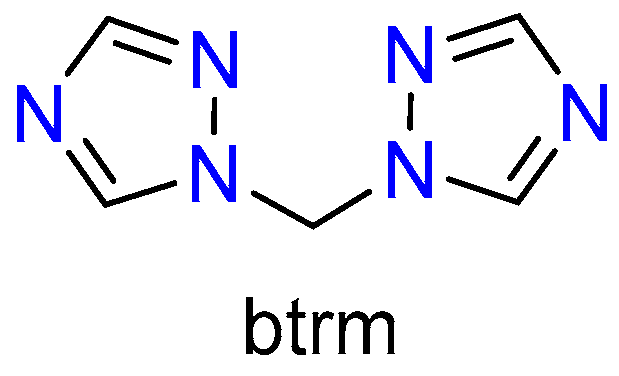
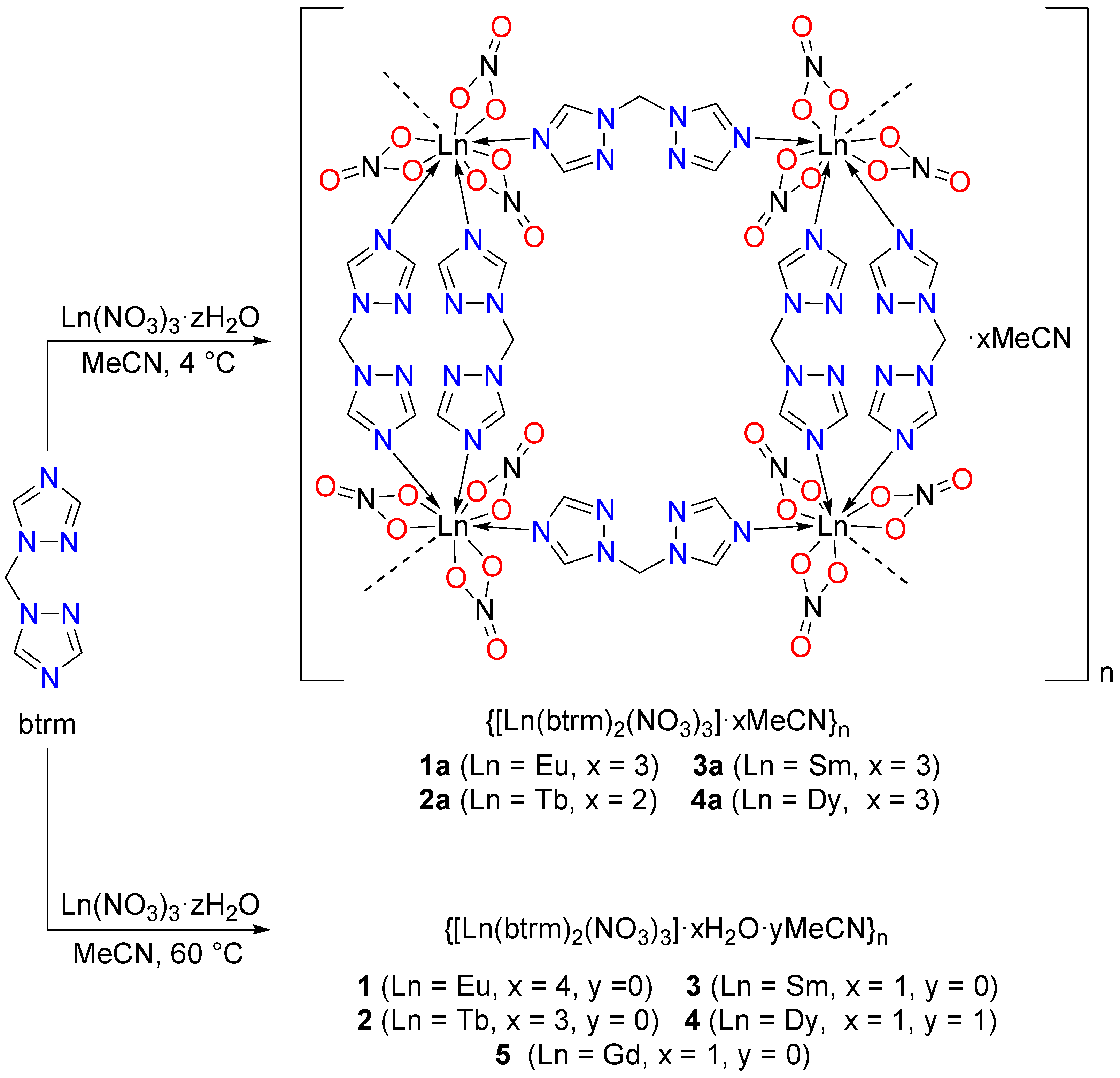
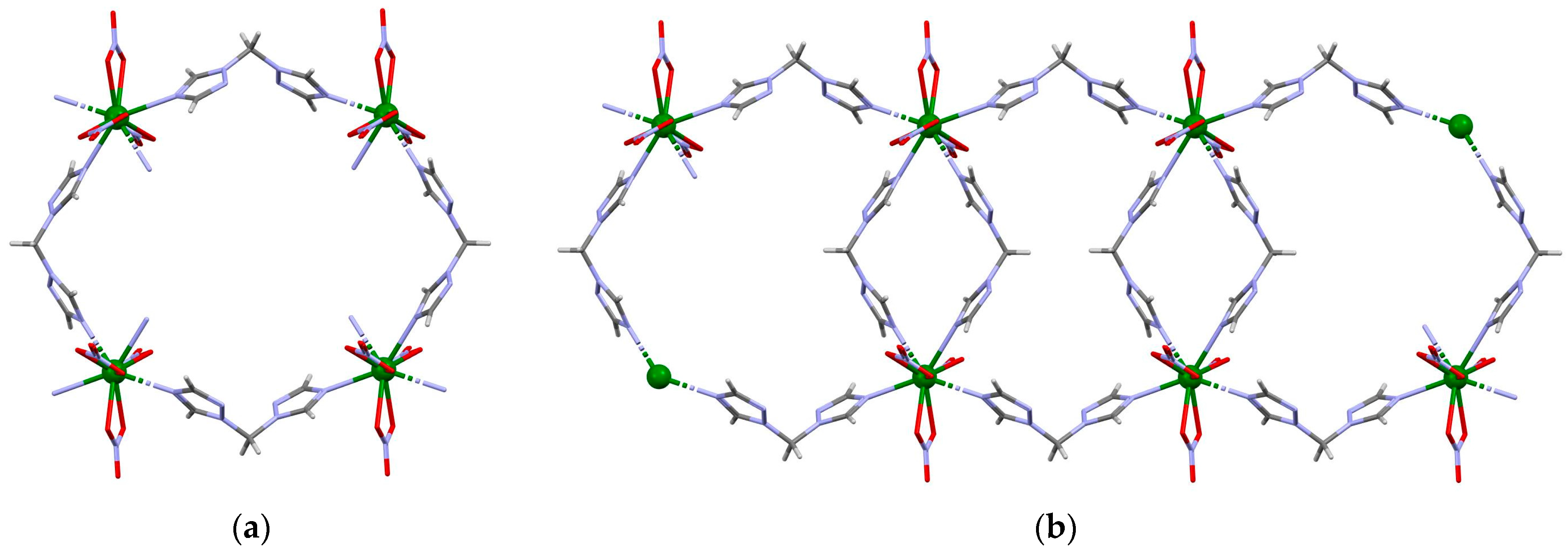
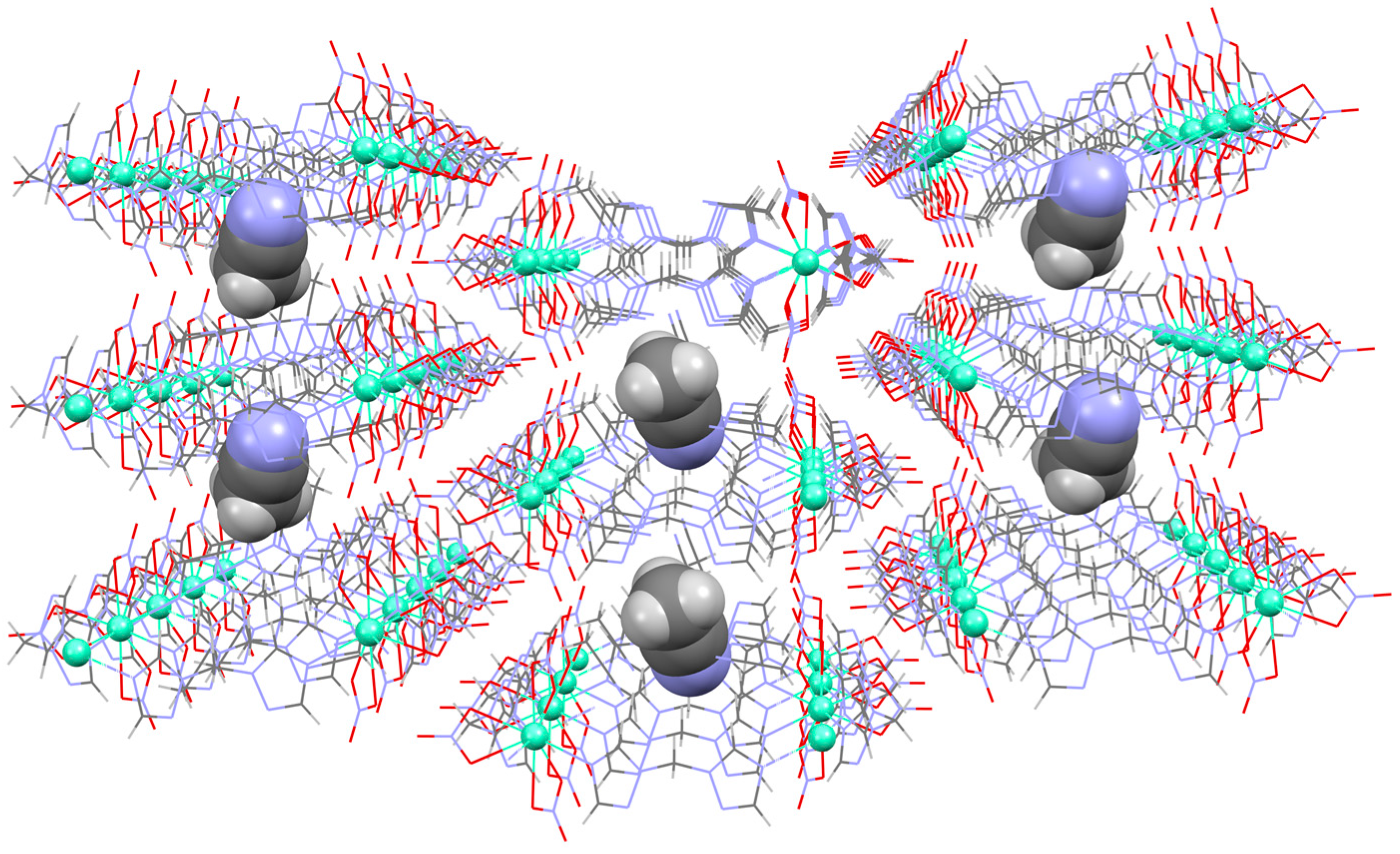
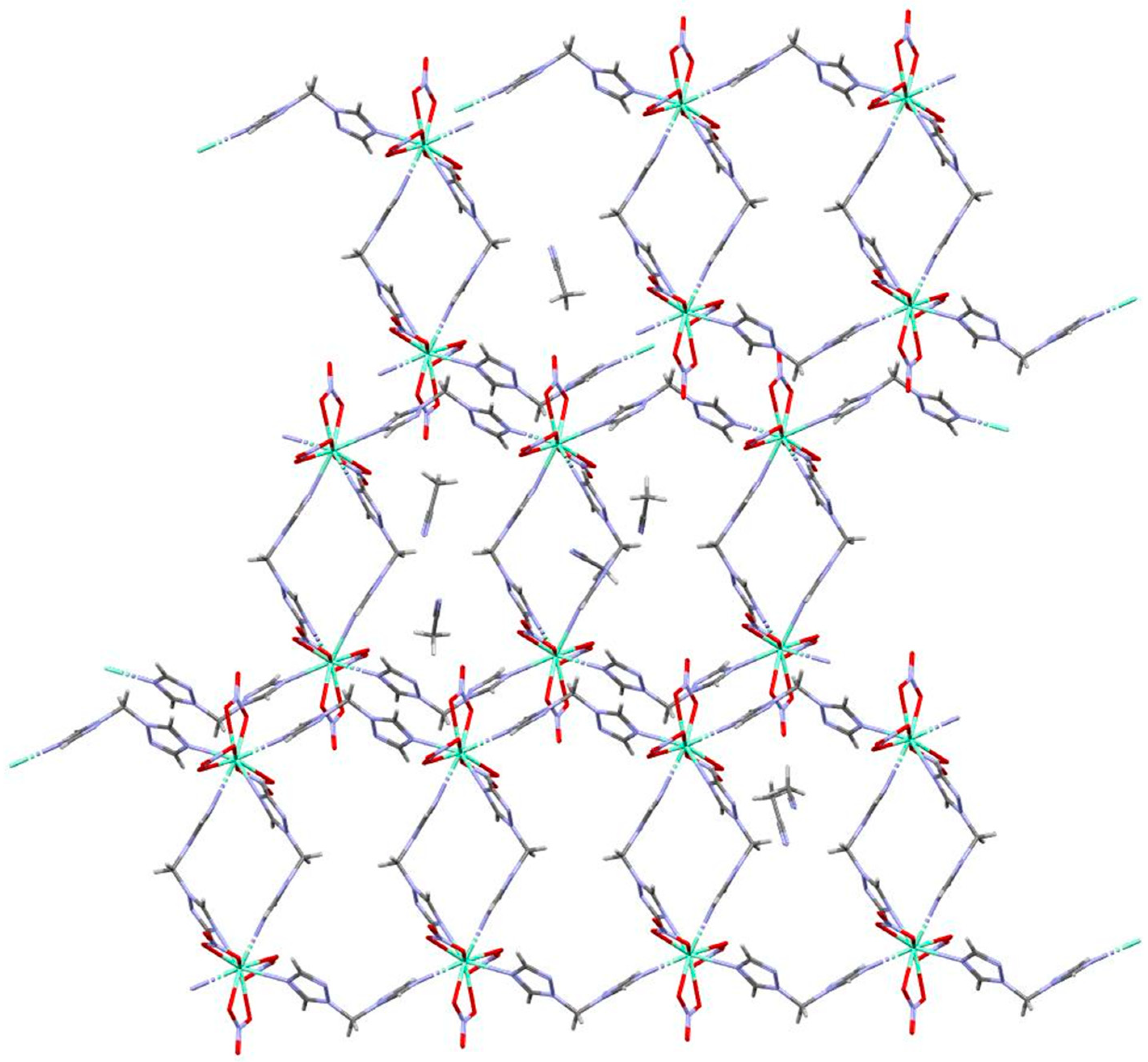


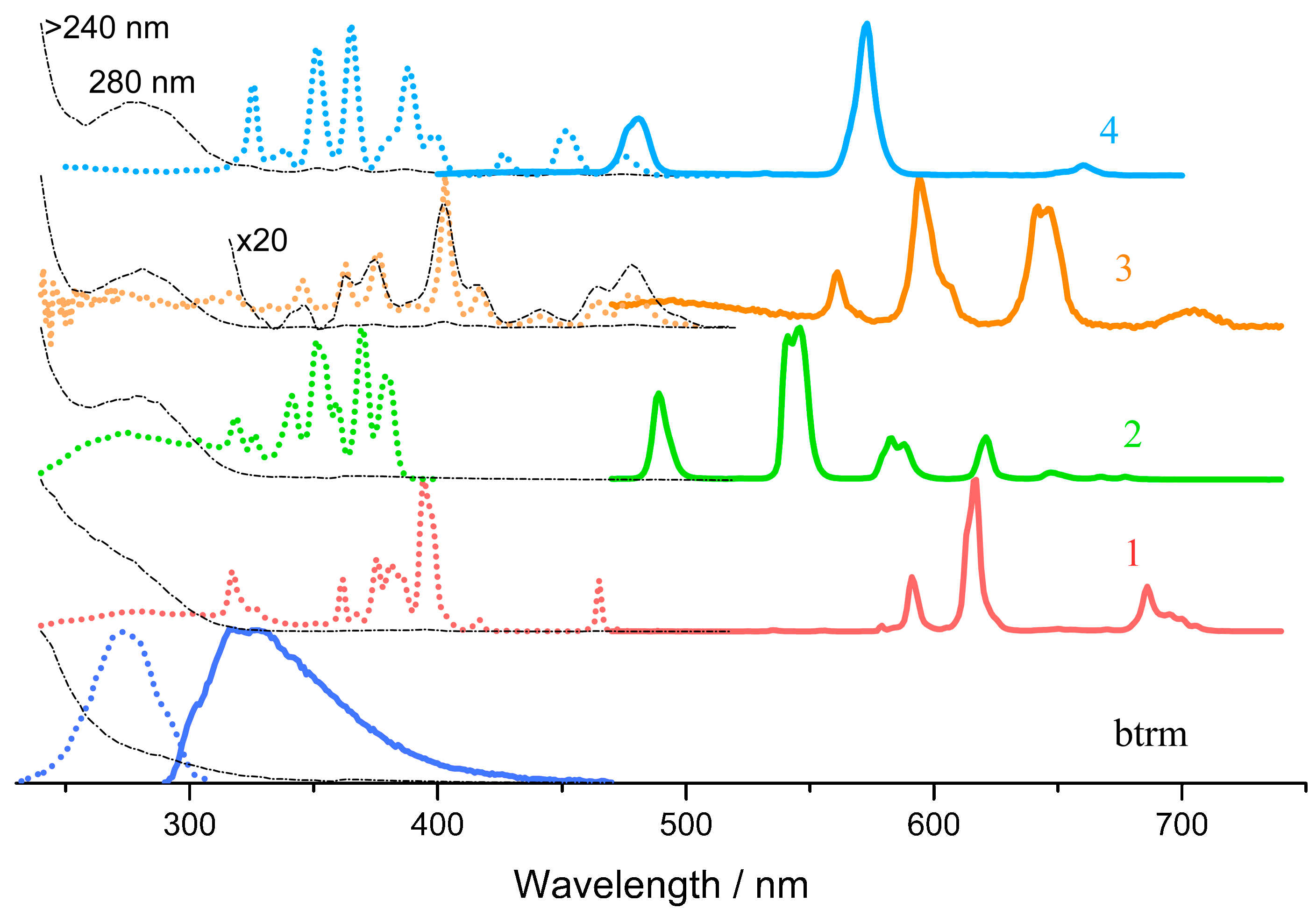
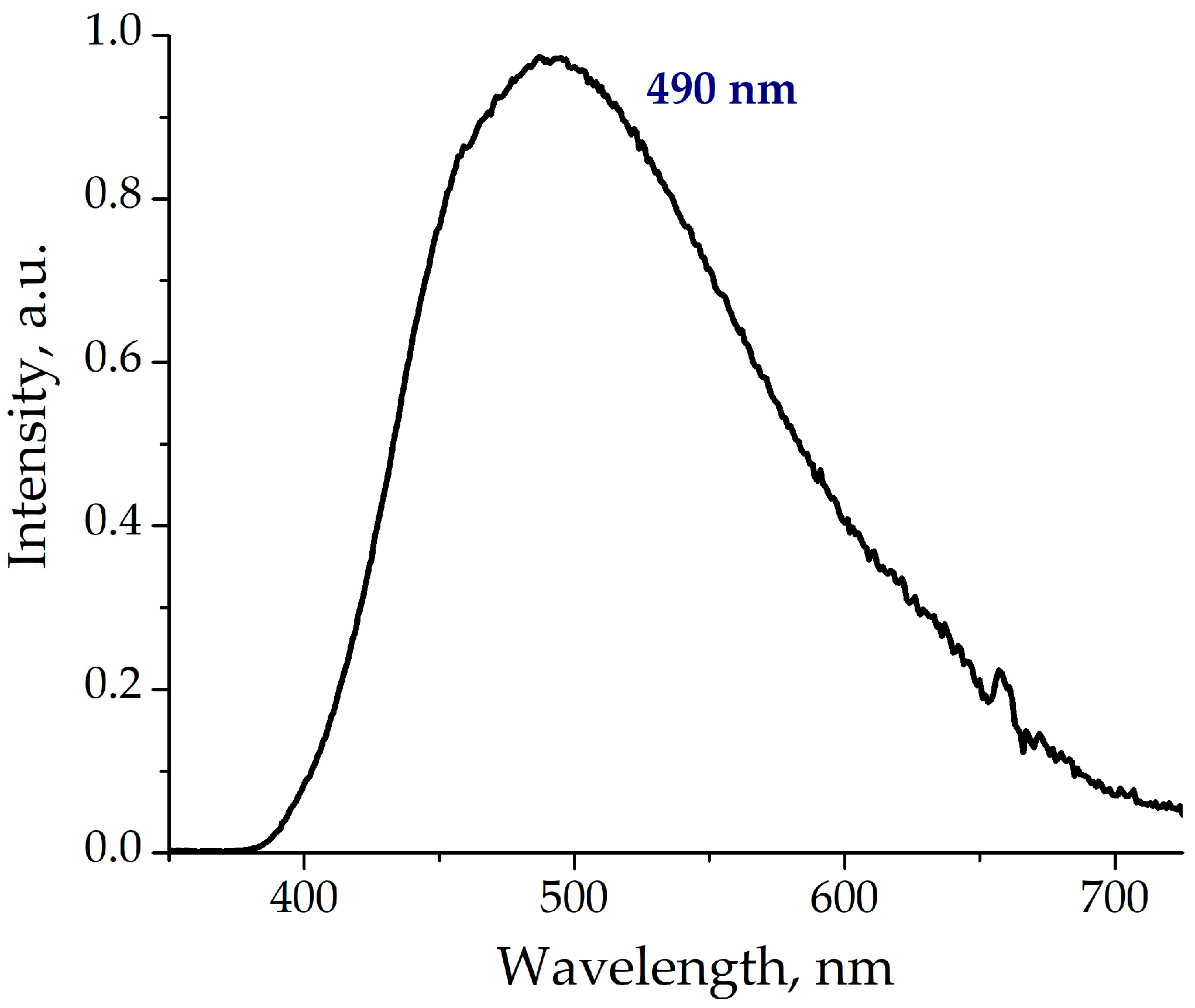
| Compound | d(M–N), Å | d(M–O), Å |
|---|---|---|
| 1a | 2.578(3) 2.579(3) 2.600(4) 2.587(4) | 2.529(3) 2.484(3) 2.499(3) 2.575(3) 2.466(3) 2.536(3) |
| 2a | 2.544(5) 2.564(6) | 2.442(5) 2.483(4) 2.554(5) |
| 3a | 2.596(3) 2.588(3) 2.601(4) 2.596(4) | 2.513(3) 2.536(3) 2.498(3) 2.486(3) 2.580(3) 2.543(3) |
| 4a | 2.545(5) 2.542(4) 2.544(5) 2.561(5) | 2.421(4) 2.442(4) 2.494(4) 2.557(5) 2.458(4) 2.521(5) |
| Compound | Lifetime, ms | QY, % |
|---|---|---|
| 1 | 0.71 | 3 (λex = 395 nm) |
| 2 | 1.17 | 4 (λex = 370 nm) |
| 3 | 0.3 | 0.1 (λex = 403 nm) |
| 4 | 0.026 | 0.4 (λex = 365 nm) |
Disclaimer/Publisher’s Note: The statements, opinions and data contained in all publications are solely those of the individual author(s) and contributor(s) and not of MDPI and/or the editor(s). MDPI and/or the editor(s) disclaim responsibility for any injury to people or property resulting from any ideas, methods, instructions or products referred to in the content. |
© 2023 by the authors. Licensee MDPI, Basel, Switzerland. This article is an open access article distributed under the terms and conditions of the Creative Commons Attribution (CC BY) license (https://creativecommons.org/licenses/by/4.0/).
Share and Cite
Ivanova, E.A.; Smirnova, K.S.; Pozdnyakov, I.P.; Potapov, A.S.; Lider, E.V. Photoluminescent Lanthanide(III) Coordination Polymers with Bis(1,2,4-Triazol-1-yl)Methane Linker. Inorganics 2023, 11, 317. https://doi.org/10.3390/inorganics11080317
Ivanova EA, Smirnova KS, Pozdnyakov IP, Potapov AS, Lider EV. Photoluminescent Lanthanide(III) Coordination Polymers with Bis(1,2,4-Triazol-1-yl)Methane Linker. Inorganics. 2023; 11(8):317. https://doi.org/10.3390/inorganics11080317
Chicago/Turabian StyleIvanova, Elizaveta A., Ksenia S. Smirnova, Ivan P. Pozdnyakov, Andrei S. Potapov, and Elizaveta V. Lider. 2023. "Photoluminescent Lanthanide(III) Coordination Polymers with Bis(1,2,4-Triazol-1-yl)Methane Linker" Inorganics 11, no. 8: 317. https://doi.org/10.3390/inorganics11080317
APA StyleIvanova, E. A., Smirnova, K. S., Pozdnyakov, I. P., Potapov, A. S., & Lider, E. V. (2023). Photoluminescent Lanthanide(III) Coordination Polymers with Bis(1,2,4-Triazol-1-yl)Methane Linker. Inorganics, 11(8), 317. https://doi.org/10.3390/inorganics11080317









